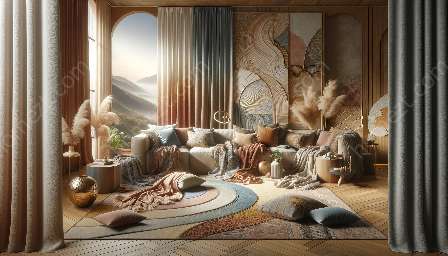Textiles and fabrics play a crucial role in interior design and home improvement. From upholstery and drapery to accent pillows and bedding, the choice of fabrics can significantly impact the look and feel of a space. This comprehensive guide explores the fascinating world of textiles and fabrics, offering valuable insights, tips, and techniques for incorporating them into interior design and home improvement projects.
Understanding Textiles and Fabrics
Before delving into how textiles and fabrics can enhance interior design and home improvement, it's essential to understand the characteristics and qualities of different materials. Textiles are broadly classified into natural and synthetic fibers, each with its own unique properties.
Natural fibers, such as cotton, linen, wool, and silk, are derived from plant or animal sources. They are prized for their breathability, comfort, and luxurious feel. On the other hand, synthetic fibers, including polyester, nylon, and acrylic, offer durability, stain resistance, and versatility.
Choosing the Right Fabrics for Interior Design
When it comes to interior design, the choice of fabrics can make a significant difference in the overall aesthetic of a space. Different fabrics evoke distinct moods and styles, and it's crucial to select the right ones to achieve the desired look.
- Upholstery Fabrics: For furniture upholstery, durable and easy-to-clean fabrics like microfiber or leather are popular choices. However, if seeking a more luxurious and elegant feel, velvet or chenille can add a touch of opulence to the interior.
- Drapery and Curtains: Sheer, lightweight fabrics like chiffon or organza can create an airy and breezy atmosphere, perfect for enhancing natural light in a space. Meanwhile, heavy and opaque fabrics such as brocade or damask offer privacy and a sense of grandeur.
- Decorative Fabrics: When it comes to accent pillows, throws, and bedding, the options are endless. From playful patterns and textures to elegant embellishments, decorative fabrics can add personality and charm to any interior.
Integrating Fabrics into Home Improvement Projects
Aside from their decorative role, fabrics can also be used to improve the functionality and comfort of a home. From sound absorption and insulation to light control and privacy, fabrics offer a multitude of practical benefits.
Sound Absorption: In spaces with hard surfaces, such as kitchens and bathrooms, the use of textiles like rugs, curtains, and upholstery can help absorb sound, reducing echoes and creating a more pleasant acoustical environment.
Insulation: Fabrics have insulating properties that can help regulate temperature and reduce energy costs. Thick curtains or drapes can prevent heat loss during winter, while light-filtering blinds can help maintain a comfortable indoor temperature in summer.
Light Control: Fabrics can effectively control the amount of natural light entering a room. Sheer fabrics diffuse and soften sunlight, creating a gentle, diffused glow, while blackout curtains and shades provide complete light blockage, ideal for bedrooms and media rooms.
Staying Ahead with Textile Trends
Like any other aspect of design, textiles and fabrics are subject to evolving trends and innovations. Staying informed about the latest textile trends can provide valuable inspiration and ideas for interior design and home improvement projects.
From eco-friendly and sustainable textiles to innovative performance fabrics, the industry continuously introduces new materials and technologies. Textile trends also encompass patterns, colors, and textures that reflect current design movements.
Final Thoughts
Textiles and fabrics are indispensable elements in interior design and home improvement, offering both aesthetic and functional advantages. By understanding the characteristics of different fabrics, choosing the right ones for specific applications, and staying attuned to evolving trends, designers and homeowners can harness the transformative power of textiles to elevate their living spaces.

